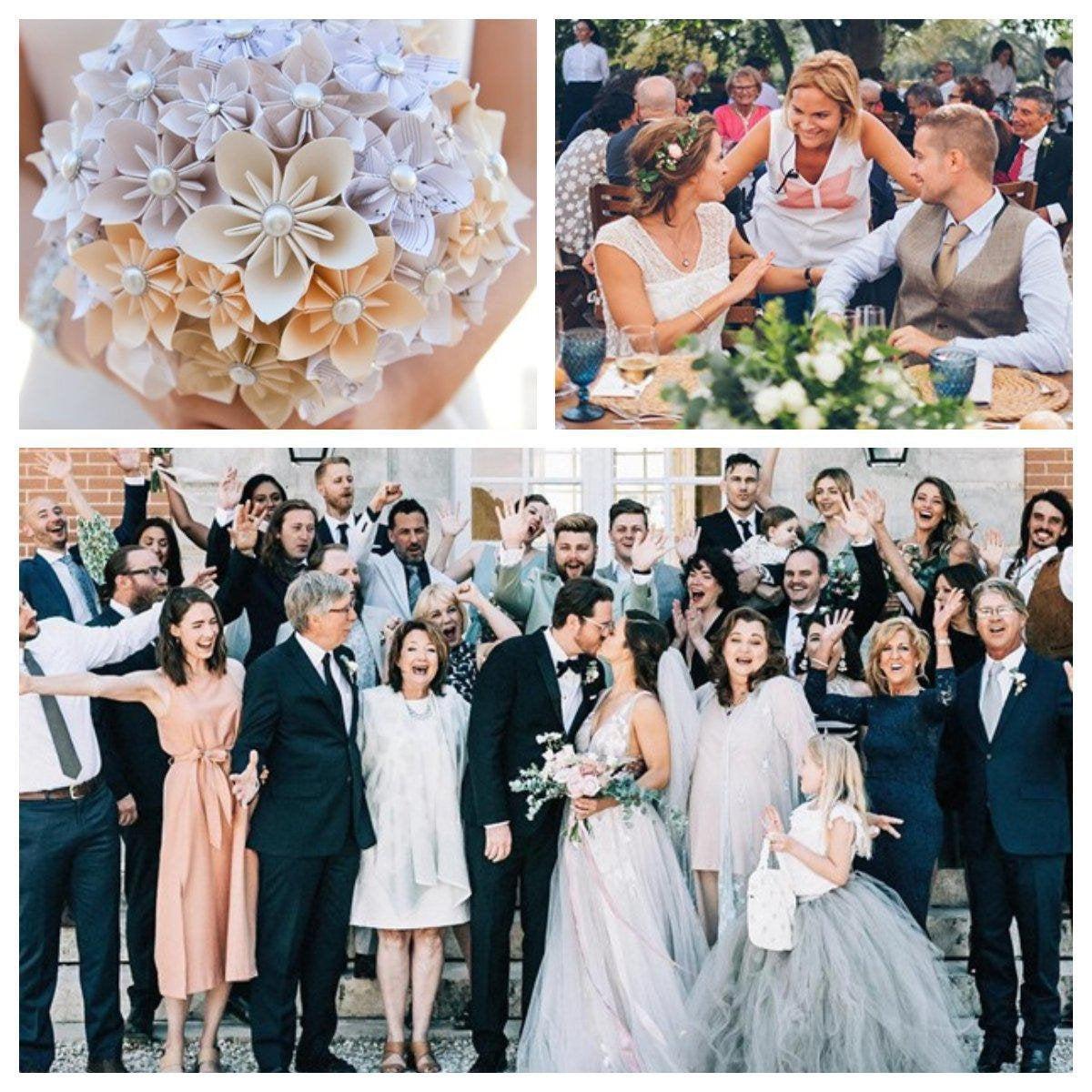Get The Latest Updates On New Arrivals, Sales + Promotions

The Ultimate Wedding Checklist - What To Start Planning 11 Months Out
11 Month Wedding Checklist - Download it here!
Create a budget


Book services

Create your guest list
Commit to colors and theme
- Colors
- Theme
DIY materials needed:
 Paper Flower Bouquet: Word to Glow, Wedding Planner Talking to the Bride and Groom: Pasion Eventos, Wedding Guests Celebrating With the Bride and Groom: Brides
Paper Flower Bouquet: Word to Glow, Wedding Planner Talking to the Bride and Groom: Pasion Eventos, Wedding Guests Celebrating With the Bride and Groom: Brides
The Ultimate Wedding Checklist - What To Start Planning 11 Months Out
At 11 months out from your wedding date, it’s time to get to work! From solidifying your date to setting a budget and trimming your guest list, this is the month where you whip out your wedding checklist notebook and start shaping how your big day will look.
Budget
The big, bad ‘B’ word for most couples isn’t ‘Bridezilla’—it’s ‘budget’. Although it can be uncomfortable, and it is rarely very much fun, it is extremely important that you and your partner agree on a budget.
Determining a budget is a very personal decision. Some couples dream of a big blowout wedding weekend where no expense is spared. Others are forced to make more realistic decisions based on what’s currently in their bank account. No matter how much you spend, you should make sure you can afford your wedding right now.
You don’t want to start your life together under a mountain of debt. If you don’t have the money for that chocolate fountain, don’t charge it on a credit card. Instead, take into account how much money you and your partner have in savings and how much you can save towards your wedding every month before you get hitched. If you find yourself woefully under budget, consider lengthening your engagement so you have more time to save.
Don’t forget to ask relatives if they are willing to help! Most are happy to pitch in by writing you a check or offering to cover the cost of certain vendors. Just make sure you graciously accept whatever help they are willing to give you, even if they can only offer you emotional support in lieu of monetary support. In addition, be willing to decline monetary support if you know it means you’re going to be obligated to make choices about the guest list, your dress, or food that will make you unhappy.
If there’s no getting around taking on some debt, be very clear with your spouse about how much you’re willing to take on, how much you’re willing to pay monthly after the wedding is over, and when you plan to pay it all off. Expectations are huge here. You don’t want resentment to breed because you’re mad that you’re paying for a full bar, because that’s what your spouse wanted, while he’s mad that you spent so much on floral arrangements that just died anyway.
There are a lot of complicated spreadsheets and wedding calculators out there that you can use, but budgeting doesn’t have to be quite so complex if you don’t want it to be. Simply make a list of all your expenses, write how much you are willing to pay, then tally up the total. If it’s too much, look for areas you can cut. When you book a vendor or purchase favors, write that amount into a third column to make sure you’re staying on track.
Remember those two or three priorities you and your spouse discussed in month 12? Make sure you keep these in mind when you’re budgeting. It’s easy to get lost in how much there is to pay for, which means you could find yourself overpaying for photos and a wedding dress when your initial focus was on food and location.
Key takeaways:
- Make sure you can afford your wedding right now. You don't want to start your marriage under a mountain of debt.
- Consider lengthening your engagement so you have more time to save.
- Ask relatives if they are willing to help, and if so, how much they are willing to contribute.
- If you choose to take on debt, make sure both you and your partner are clear on how much and how long you will take to pay it off.
- Make a list of all of your expenses, how much you’re willing to pay, and how much you actually pay to make sure your budget stays on track.
Commit to a Date
Last month you dreamed about when your wedding would take place. You may have thought about a summer bash next to the beach or an autumnal affair surrounded by falling leaves. Hopefully you have considered a few different dates that would work well for you and your partner. Once you have decided on a budget, it’s time to solidify that date, if you haven’t already.
Having trouble coming to an agreement? Speak with your venue to see if one of your wedding dates is available, or if one is priced differently, as some dates command premium prices while others can be snatched up at a discounted rate. It may help you decide on a date when you couldn’t decide before.
Don’t let just anyone have a say in your wedding date, as everyone is likely to have an opinion, but if you’re really struggling, consider talking with a trusted friend or family member. Your mom can tell you if your grandma would think it appropriate to have your wedding on your grandparents’ anniversary, while a friend may caution you to choose a different date if the date you have in mind happens to be another friend’s birthday.
No matter how you go about making your decision, if it hasn’t been made yet, you must choose the date now. So much of the planning process depends on it.
Key takeaways:
- Speak with your venue about their available dates.
- Talk to loved ones about appropriate wedding dates.
- Solidify your date before you move forward in the planning process.
Book Services
Hopefully you have already begun the process of searching for venues and vendors, but at the 11 month mark is when you start making decisions and booking professionals you want to have involved on your wedding day.
If you’re a budget bride, this is also the time when you make a commitment to the services you are willing to pay for, and the services you will not have at your wedding. For example, if you’ve got limited funds, you and your partner may have decided that a cake is one of the two or three things that is important to you both, but flowers? Not so much. You may decide to decorate with thrifted items, candles, and silk flowers so you can save on a florist.
In general, you can book services in any order, but you should always book your ceremony and reception venues first. Some vendors may only work with one caterer, while others may provide you with a list of caterers to choose from. Some venues also have items, like chairs, tables, and votive candle holders that you can use, which means less you’ll have to rent later. In addition, they can also provide you with a list of other vendors they have worked with before, which can make your search for the perfect florist or baker a lot easier.
If you’ve got the budget, you may also want to consider vendors that will make your wedding unique. A few ideas include:
- Photo booth rentals
- Live chef services
- Food trucks
- Caricature artists
- Dancers
- Performance acts
- Animals
Key takeaways:
- Eliminate vendors you don’t need from your budget.
- Book your ceremony and reception venues first.
- Consider unique wedding vendors.
Guest List
Who you invite to your wedding can completely change the look and feel of your day. Hosting a small dinner after a courthouse wedding is very different than partying the night away with 250 guests.
Once you and your partner have decided if you want an intimate or more raucous affair, it’s time to start zeroing in on the people you want to invite. You should make decisions based on tiers of importance:
- Immediate family members, like mom, dad, siblings, grandma, and grandpa
- Best friends whom you have remained in close contact with throughout the last year
- Close family members, like cousins, aunts, and uncles
- Old friends whom you check in with once or twice a year
- Work friends that you actually spend time with outside of work
- Bosses and supervisors
- Distant relatives whom you may not have seen or spoken to in years
- Acquaintances, which includes coworkers you rarely see outside of the office
- Old friends whom you haven’t spoken to in years
- Friends of your parents whom you barely know or haven’t met
Are you a budget planner who is looking for ways to keep costs low? Trimming your guest list is one of the best ways to do that. Make a list of guests and assign them to the numbers above. Then, start eliminating tens, nines, and so on until you have a list that you and your spouse can agree on.
Don’t automatically assume it means all of a certain number has to be eliminated either. For example, if your parents are helping you pay for your wedding, you may have to get rid of a few nines so they can invite their friends who are listed as tens.
If you’re still struggling, think more broadly about who is invited. You might decide to invite single friends and family without enabling them to bring a plus one, or you may decide to ask guests under ten to stay home.
Don’t let pity or guilt guide your decisions. You should be allowed to share your special day with whoever is most important to you. However, if you know you can easily avoid family drama by inviting your great aunt Ethel, it might not be so bad to invite her if you have a large guest list and it will be easy to avoid her. The exception would be for small weddings where guests are limited, in which case you can simply let her know that she wasn’t the only one who didn’t get an invite.
Once you have finalized your guest list, you should start sourcing addresses immediately. It can take a while to make sure you have the correct addresses for everyone on your list!
Key takeaways:
- Eliminate guests based on their unimportance in your life.
- Consider not extending invitations to plus ones and young children to keep costs low.
- Don’t let pity guide your decisions—you deserve to celebrate with the people you care about most.
- Start collecting addresses right away.
Commit to Colors and Theme
Chances are, you have spent much of month 12 browsing Pinterest and gathering inspiration from bridal and décor sites. Looking at all that inspiration can be a lot of fun, but it’s time to start making some commitments to the theme and colors you want.
Are you struggling to make a commitment? Take a step back and consider your personal style. Do you like to dress casually or would your friends call your style boho chic? Look around your home. Are you a minimalist who likes crisp, clean lines and shades of white, or is your home a kaleidoscope of color?
Let your real life inspire you to decide on a theme and color scheme. It will be a more authentic representation of you and your partner, and it has the potential to make life a little easier for you. If you choose a theme and color scheme that is near and dear to your heart, you may find that there are items you already have in your home that you can integrate into your wedding. Artwork can be hung inside your reception space, poufs from your living room can be used in a lounge area, and serving dishes could be used at dinner.
Once you’ve decided on your theme and color scheme, it’s time to start getting to work. Start sourcing materials and gathering supplies if you plan on DIYing some of the décor at your wedding. Once you have those supplies, start putting them together. The earlier you start, the more time you have to perfect the wedding day look of your dreams.
This is also the time to reach out to friends and family who might be willing to help you. Enlist your craftiest friends and family to help you create centerpieces and ceremony décor. Schedule making parties where everyone gets together to start assembling flowers, or create a schedule for friends and family so they know exactly what to make and when everything has to be done. Although it seems a bit controlling, it ensures everyone knows exactly how to help, and it ensures you don’t show up the day before your wedding and realize that one of your bridesmaids is just now finishing up your flower garlands when she should have finished them weeks ago.
Key takeaways:
- Let your life and personal style help you zero in on a theme and colors.
- Start sourcing DIY materials and other décor.
- Ask crafty friends and family to help.














